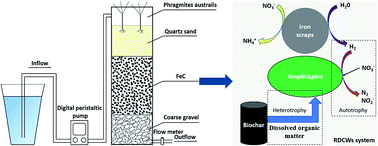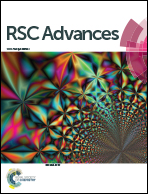The contributions and mechanisms of iron-microbes-biochar in constructed wetlands for nitrate removal from low carbon/nitrogen ratio wastewater†
Abstract
The removal efficiency of nitrate from low carbon/nitrogen ratio wastewater has been restricted by the lack of organics for several decades. Here, a system coupling chemical reduction, microbial denitrification and constructed wetlands (RDCWs) was developed to investigate the effect and possible mechanisms for nitrate degradation. The results showed that this coupling system could achieve a nitrate removal efficiency of 97.07 ± 1.76%, 85.91 ± 3.02% and 56.63 ± 2.88% at a hydraulic retention time of 24 h, 12 h and 6 h with feeding nitrate of 15 mg L−1, respectively. These removal efficiencies of nitrate were partly caused by microbes and biochar with a contribution rate of 31.08 ± 4.43% and 9.50 ± 3.30%. Besides, microbes were closely related to iron and biochar for the removal of nitrate. Simplicispira was able to utilize hydrogen produced by iron corrosion as an electron donor while nitrate accepted electrons to be reduced. Porous biochar could release dissolved organic matter, which provided a good living circumstance and carbon source for microbes. Therefore, the RDCW system is potential for large-scale application due to its low cost and simple operation.



 Please wait while we load your content...
Please wait while we load your content...